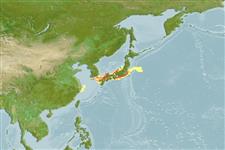>
Ophidiiformes (Cusk eels) >
Bythitidae (Livebearing brotulas)
Etymology: Parabrotula: Greek, para = the side of + Latin, brotula, -ae = little, bud, shoot (Ref. 45335); tanseimaru: Named after R/V Tansei Maru.
Eponymy: ‘Tansei Maru’ is the name of a research vessel, owned by the Ocean Research Institute, University of Tokyo (now Japan Marine Science and Technology Center), which was responsible for collecting the holotypes of the goby and false brotula. (Ref. 128868), visit book page.
More on authors: Miya & Nielsen.
Environment: milieu / climate zone / depth range / distribution range
Ecologia
marinhas batipelágico; intervalo de profundidade 0 - 1300 m (Ref. 34721). Deep-water
Northwest Pacific: Japan.
Tamanho / Peso / Idade
Maturity: Lm ? range ? - ? cm
Max length : 5.0 cm SL macho/indeterminado; (Ref. 34721); 5.0 cm SL (female)
Occurs in pseudoceanic bathypelagic depths. Feeds primarily on copepods (Ref. 34721). Viviparous (Ref. 34721).
Ciclo de vida ou comportamento de acasalamento
Maturidade | Reprodução | Desova | Ovos | Fecundidade | Larvas
Miya, M. and J.G. Nielsen, 1991. A new species of the deep-sea fish genus Parabrotula (Parabrotulidae) from Sagami Bay with notes on its biology. Jap. J. Ichthyol. 38(1):1-5. (Ref. 34721)
Status na Lista Vermelha da UICN (Ref. 130435: Version 2024-2)
Ameaça para os humanos
Harmless
Uso pelos humanos
Ferramentas
Relatórios especiais
Baixar XML
Fontes da internet
Estimates based on models
Preferred temperature (Ref.
123201): 0.7 - 16.4, mean 8.5 °C (based on 34 cells).
Índice de diversidade filogenética (Ref.
82804): PD
50 = 0.8750 [Uniqueness, from 0.5 = low to 2.0 = high].
Bayesian length-weight: a=0.00813 (0.00246 - 0.02688), b=2.92 (2.67 - 3.17), in cm total length, based on LWR estimates for this (Sub)family-body shape (Ref.
93245).
Nível Trófico (Ref.
69278): 3.0 ±0.00 se; based on food items.
Resiliência (Ref.
120179): Elevada, tempo mínimo de duplicação da população menor que 15 meses (Preliminary K or Fecundity.).
Fishing Vulnerability (Ref.
59153): Low vulnerability (10 of 100).
